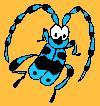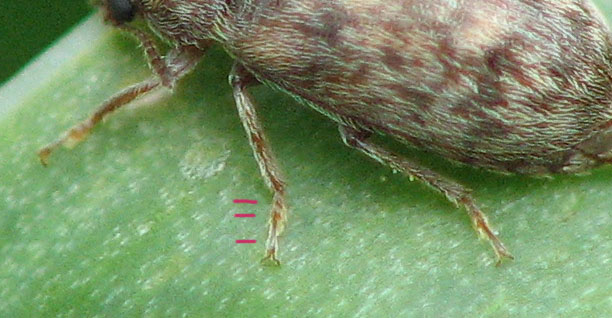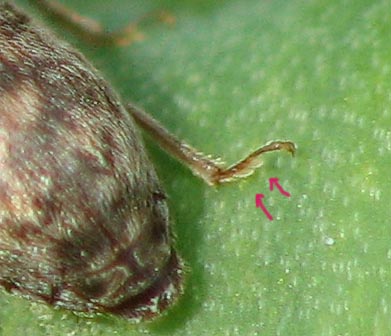|
|
|
|
|
Galleria Tassonomica
di
Natura Mediterraneo
|
 Nota! La determinazione degli insetti necessita quasi sempre di un'indicazione geografica e temporale precisa. Nota! La determinazione degli insetti necessita quasi sempre di un'indicazione geografica e temporale precisa.
Invitiamo quindi gli utenti ad inserire questi dati ogni volta che viene richiesta una determinazione o viene postata una foto di un insetto. I dati forniti dagli utenti ci consentiranno anche di attribuire un valore scientifico alle segnalazioni, contribuendo a migliorare e integrare le attuali conoscenze sulla distribuzione delle specie postate.
|
|
| Autore |
 Discussione Discussione  |
|
|
Assaf
Utente V.I.P.
  
Città: Haifa

343 Messaggi
Flora e Fauna |
|
|
orni
Utente Senior
   
Città: Portoferraio
Prov.: Livorno
Regione: Toscana

3547 Messaggi
Tutti i Forum |
 Inserito il - 18 febbraio 2008 : 01:39:51 Inserito il - 18 febbraio 2008 : 01:39:51


|
Looks like Bruchidae to me...
Ciao Ornella |
 |
|
|
MarcoU
Utente Senior
   

Città: Codevigo
Prov.: Padova
Regione: Veneto

697 Messaggi
Flora e Fauna |
 Inserito il - 18 febbraio 2008 : 10:53:19 Inserito il - 18 febbraio 2008 : 10:53:19


|
| Surely not Anobiidae Ptininae and not Bruchidae. I'd think to Mycetophagidae, but I have to sey that I have never seen anything like this. |
Modificato da - vladim in data 16 maggio 2017 14:03:27 |
 |
|
|
Assaf
Utente V.I.P.
  
Città: Haifa

343 Messaggi
Flora e Fauna |
 Inserito il - 18 febbraio 2008 : 13:22:22 Inserito il - 18 febbraio 2008 : 13:22:22


|
Thanks MarcoU,
In my records I known of only four Mycetophagidae sp. from this area:
Typhae fumata (Linnaeus, 1758)
Typhae stercorea (Linnaeus, 1758)
Litargus coloratus (Rosh, 1856)
Berginus tamarisci (Wollaston, 1854)
Do you have any information on those sp. ?
P.S How can I tell this is no Bruchidae? should I look for any specific characteristic?
|
 |
|
|
MarcoU
Utente Senior
   

Città: Codevigo
Prov.: Padova
Regione: Veneto

697 Messaggi
Flora e Fauna |
 Inserito il - 18 febbraio 2008 : 14:30:45 Inserito il - 18 febbraio 2008 : 14:30:45


|
Surely not
Typhaea stercorea (Linnaeus, 1758)
Berginus tamarisci (Wollaston, 1854)
Typhaea fumata (Linnaeus, 1758)
and
Litargus coloratus (Rosh, 1856)
are to me unknown, but both geneara are suitable. I don't remember diagnostic characters, but I would bet on genus Litargus
Bruchidae have usually a very different appearance:
Shorter body, pygidium (dorsal part of last abdominal segment) visible from above, elytra truncated and/or separately rounded at the apex, antennae filiform or dentate/serrate but without distinct club, legs longer and stronger, in particular back legs have thickened femora.
Hope this help.
By the way, may I ask if you received any private message/email from me?
cordially, Marco
|
 |
|
|
Vitalfranz
Utente Senior
   

Città: Luxembourg
Regione: Luxembourg

2500 Messaggi
Flora e Fauna |
 Inserito il - 23 febbraio 2008 : 13:03:14 Inserito il - 23 febbraio 2008 : 13:03:14


|
Typhaea fumata is only a synonym of Typhaea stercorea, a uniformly testaceous species (Link ) . ) .
On the other side, Litargus looks a quite different genus.
Personally, I do not think either this species belongs to Mycetophagidae, due to the posteriorly constricted pronotum (so it looks to me).
If you can check the number of tarsal joints we might have some dignostic elements. Also Cryptophagidae might be a possible ID.
Francesco Vitali
|
 |
|
|
Assaf
Utente V.I.P.
  
Città: Haifa

343 Messaggi
Flora e Fauna |
 Inserito il - 24 febbraio 2008 : 00:05:34 Inserito il - 24 febbraio 2008 : 00:05:34


|
Francesco,
I don't have good photo of the leg. Too me mid leg seem to have 3 tarsal joints. but I'm not expert it could be 4 so Cryptophagidae maybe is possible.
The following Cryptophagidae found near this area, Are anyone of them looks close?
Leucohimatium arundinaceum (Forskal, 1775)
Cryptophagus laticollis (Lucas, 1849)
Cryptophagus cellaris (Scopoli, 1763)
Micrambe vini (Panzer, 1797)
Curelius exiguus (Erichson, 1846)
Immagine:

91,25 KB
|
 |
|
|
Vitalfranz
Utente Senior
   

Città: Luxembourg
Regione: Luxembourg

2500 Messaggi
Flora e Fauna |
 Inserito il - 24 febbraio 2008 : 08:53:20 Inserito il - 24 febbraio 2008 : 08:53:20


|
None of them. 
The general habitus reminds me of a Fruitworm Beetle (Byturidae), even if its pubescence is spotted rather than uniform.
In the BugGude of American species I've found this species, very alike to yours, but I don't know if you have similar beetles.
Francesco Vitali
|
 |
|
|
Assaf
Utente V.I.P.
  
Città: Haifa

343 Messaggi
Flora e Fauna |
 Inserito il - 24 febbraio 2008 : 23:57:11 Inserito il - 24 febbraio 2008 : 23:57:11


|
Francesco,
Great identification 
I think you'r right. Here what I found on Family BYTURIDAE "The tarsal formula is 5-5-5; the second and third tarsal segments bear distinctive plate-like lobes and the claws are toothed basally."
Immagine:

63,23 KB
On bugguide I found "Adults feed at a variety of flowers. Larvae often in native fruits, or in oak galls in the case of Xerasia grisescens."
And indeed I found it in oak forset standing on flowering Asphodelus.
So I think it is sure to say Xerasia but is it X.grisescens? I don't know if X.grisescens is palearctic but I do know it is possible to find X.punica Goodrich et Spriger, 1980 near my area. could it be X.punica ? |
Modificato da - Assaf in data 24 febbraio 2008 23:57:38 |
 |
|
|
Vitalfranz
Utente Senior
   

Città: Luxembourg
Regione: Luxembourg

2500 Messaggi
Flora e Fauna |
 Inserito il - 25 febbraio 2008 : 00:31:15 Inserito il - 25 febbraio 2008 : 00:31:15


|
Maybe.
In Biolib I've collected the names of four Xerasia-species (one from middle Europe and the other one from Japan), but unfortunately, I don't know anything about them except for their names...
Francesco Vitali
|
 |
|
|
MarcoU
Utente Senior
   

Città: Codevigo
Prov.: Padova
Regione: Veneto

697 Messaggi
Flora e Fauna |
 Inserito il - 25 febbraio 2008 : 09:52:22 Inserito il - 25 febbraio 2008 : 09:52:22


|
It seems you are right! I was unaware of the existence of this genus! The Byturidae I'm used to see in Italy (Byturus sp.) have a rather different appearance, as Francesco knows.
To fill this gap in my knowledge I have just asked for a PDF of the following paper...
Goodrich, M. A. and C. A. Springer. 1988. A new species of Xerasia (Coleoptera: Byturidae) from the Middle East, with a key to the Xerasia of the world. Coleop. Bull. 42(4):345-351.
Maybe it will give us more precise ideas...
|
 |
|
|
vladim
Moderatore trasversale
    

Città: Milano
Prov.: Milano
Regione: Lombardia

34172 Messaggi
Tutti i Forum |
 Inserito il - 27 luglio 2016 : 05:30:59 Inserito il - 27 luglio 2016 : 05:30:59


|
A proposito dei messaggi precedenti, in cui si accennava alla "famiglia Bruchidae", si sottolinea che
la famiglia Bruchidae è divenuta una sottofamiglia all'interno della famiglia Chrysomelidae.
Quindi ora si ha Chrysomelidae Bruchinae.

|
 |
|
| |
 Discussione Discussione  |
|
|
|
 Natura Mediterraneo Natura Mediterraneo |
© 2003-2024 Natura Mediterraneo |
 |
|
Leps.it | Herp.it | Lynkos.net
|

 Forum
|
Registrati
|
Msg attivi
|
Msg Recenti
|
Msg Pvt
|
Utenti
|
Galleria |
Map |
Forum
|
Registrati
|
Msg attivi
|
Msg Recenti
|
Msg Pvt
|
Utenti
|
Galleria |
Map |